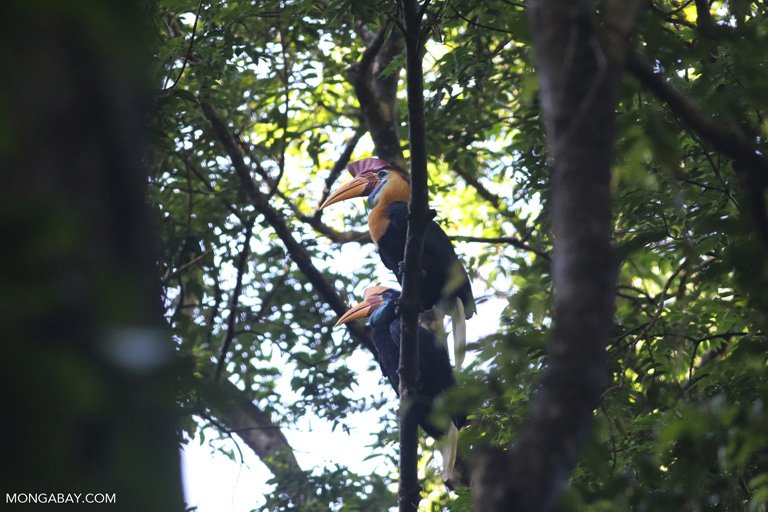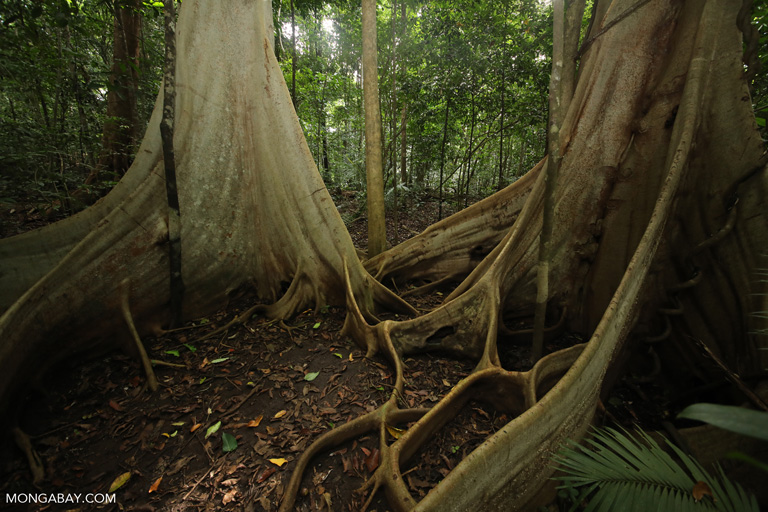- Almost half of the black macaques on Sulawesi island live in the Tangkoko Batuangus Nature Reserve, which is still home to ancient forest.
- Hunting of the macaques has declined, and the local population is showing signs of a rebound.
- But fires set by local people to clear land for planting is seen as a major threat to the species.
TANGKOKO BATUANGUS NATURE RESERVE, Indonesia — For 55-year-old Nestor Mirontoneng, the years he has spent guiding visitors as they trek this sloping landscape on Sulawesi island have brought him a new purpose: to protect the forest from fires.
As he traversed it last month, Mirontoneng told stories of hiking the terrain that started when he was only 17 years old, when he began to slow down to avoid stepping on noisy fallen branches.
“Look, a hornbill is hiding behind those leaves,” he whispered, pointing up at a bird in the trees.

The rapid destruction of the bird’s forest habitat coupled with widespread hunting have caused its population — and that of other dwindling species — to plummet.
For decades, hunting and eating bushmeat was considered an inherited tradition by local communities here in northern Sulawesi, a top reason for the drastic decline of some of these animals, especially the Sulawesi black macaque (Macaca nigra).
The creature has unusually striking reddish-brown eyes for a primate. The Macaca Nigra Project estimates that about 40 percent of the some 5,000 macaques in Sulawesi live in Tangkoko, which still has a large extent of primary forest.
The alarming rate of population drop of these species was what prompted Mirontoneng, who lives within the landscape, to be a civil partner of the forest ranger and help the government’s Natural Resources Conservation Agency (BKSDA) protect the zone.
Efforts to stem the macaque’s decline appear to have shown success. The number of macaques per square kilometer in the area jumped to 61.5 in 2011 from 53.8 in 2005 and 32.4 in 1999, according to research published in 2013.
“Fifteen years ago it looked like this macaque population would continue its decline and eventually disappear,” said Randall Kyes, a University of Washington professor who led the inquiry.
“[It] doesn’t mean that everything is fine now and that we no longer need to worry about the fate of these animals, but it is good news compared with what we’ve seen over the past 30-plus years in this reserve.”
Jenly Gawina, a government official who manages tourism in Tangkoko, agreed.
But if hunting has declined, the macaques are now threatened by recurring fires, typically started by local community members as a cheap way to clear land for planting.
“The worst fires happened in 2015,” Gawina said.

That year, fires across Indonesia ravaged more than 2 million hectares (7,722 square miles) of land, mainly in the vast peat swamp zones of Sumatra and Borneo which have been widely drained and dried for agriculture.
It isn’t clear what caused the fires here. “But it is strongly believed that men did it on purpose,” Gawina said.
“We often receive threats from local people who claim the nature reserve belongs to them, that it was inherited by their ancestors.”
Eight attempts to deploy water-bombing aircraft failed to douse the flames. Finally the rain put them out.
Some 2,000 hectares of Tangkoko Batuangus were destroyed in fire between August and October of that year, with reports of animal deaths, including two green paper snakes, three pythons, and two cuscuses. No macaques died.

Gawina said his office continuously campaigns to local communities about the importance of conserving the forest and protecting wildlife in Tangkoko Batuangus.
“Our staff may be small in number, but that doesn’t discourage from continuing our efforts to protect the conservation zone of Tangkoko.”
Banner: A Sulawesi black macaque in the Tangkoko Batuangus Nature Reserve. Photo by Rhett A. Butler/Mongabay.
This story was reported by Mongabay’s Indonesia team and was first published on our Indonesian site on May 29, 2017.
FEEDBACK: Use this form to send a message to the author of this post. If you want to post a public comment, you can do that at the bottom of the page.
